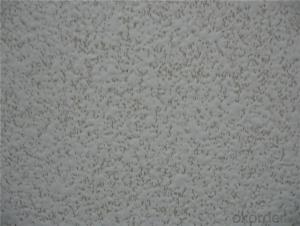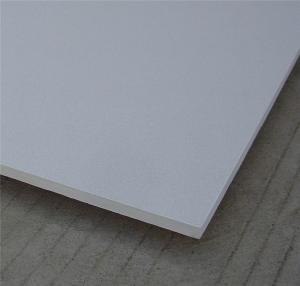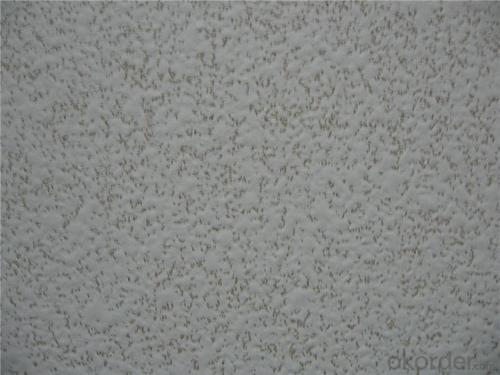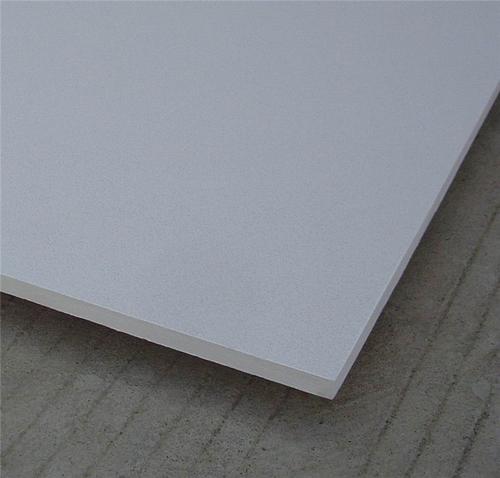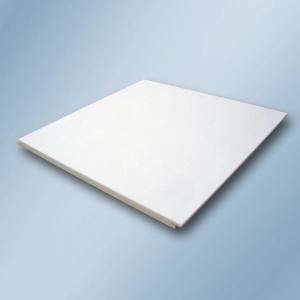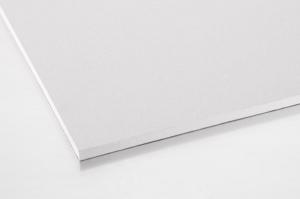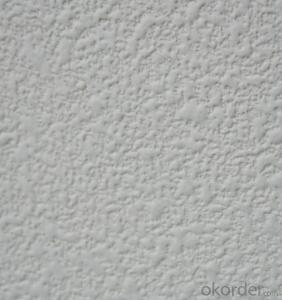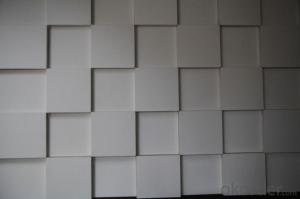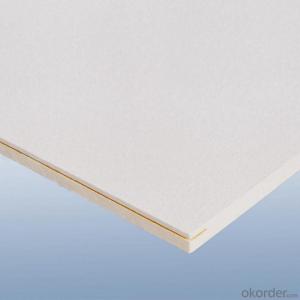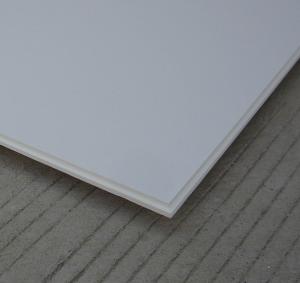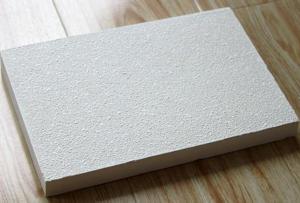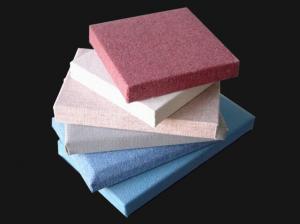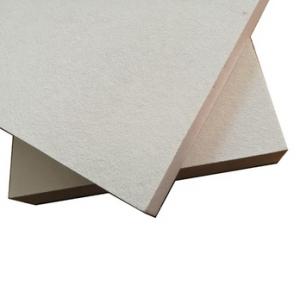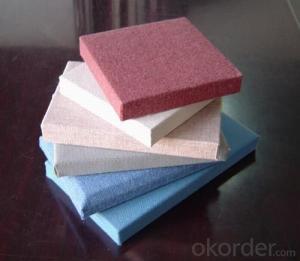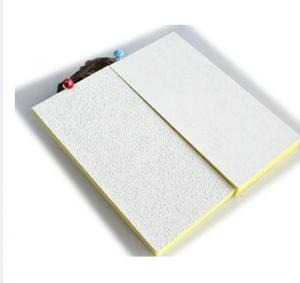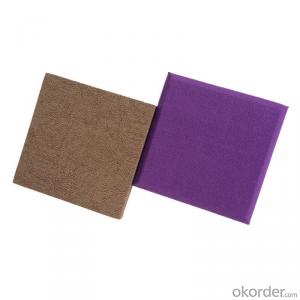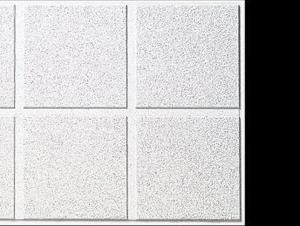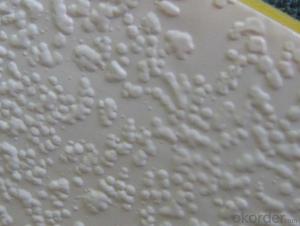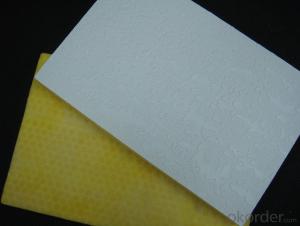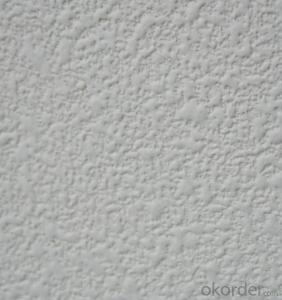Fiberglass Suspended Ceiling Panels - Insulation Acoustic Sound Proof Ceiling
- Loading Port:
- Shanghai
- Payment Terms:
- TT OR LC
- Min Order Qty:
- 3000 m²
- Supply Capability:
- 300000 m²/month
OKorder Service Pledge
OKorder Financial Service
You Might Also Like
Description:
Fiberglass Ceiling Tiles is one new kind of High-Grade decoration ceiling and wall products ,it is widely used in many performance space ,Churchs,Musemums,Nice Public Place And Some More Big Project ;Now its usage and installation place is more and more ,it has become one new popular acoustic ceiling products ,it must get more market shares in near future ;
Specification:
1) Best quality fiberglass wool as raw material ;
2) Good photopathy,Best Noise Reduction Coefficient,Good Thermal Insulation,Fire Resistance A, Easy To Install;
3) Edge: Square Edge,Tegular Edge,Concealed Edge ;
4) NRC: 0.9-1.0
5) Raw Material: Level A(Incombustible Class)
6) Coefficient Of Heat Preservation:0.042W/(M.K)
7) Specification :
1) Size: 600mmX600mm,600mmX1200mm and any size according to your request;
2) Density: 100KG/M3,120KG/M3,130KG/M3
3) Thickness: 15mm,20mm,25mm,30mm,35mm,45mm
Main Characteristic:
*Very high sound absorption, Class A
*Fire-resistant: A1
*Moisture resistance: 99%
*No sagging, No to crack
*Green building material, no radioactive species limitation contained
1) Use fiberglass wool as raw material
2) Good photopathy, noise and thermal insulation, fire resistance, easy to install and maintenance
3) Widely used in the places with special requirements to light
4) Edges: square, tegular, concealed
5) NRC: 0.8 - 1.0
6) Level of fireproofing:A2
Raw material: level A (incombustible class)
b) Surface: A2 flame( resistant class)
7) Coefficient of heat preservation: 0.046W / (M.K)
8) Radioactive species limitation: None
Application:
office building, commercial facilities,
shopping mall, Airport and school,Halls etc.
Installation method:
Use exposed grids, beautiful finish
ceiling are easy to trim and install
Both inches and metric grids are available
FAQ
1.Sample: small sample can be offered by free
2.OEM: OEM is accepted
3.MOQ: small order is ok
4.Test: any third party is accepted to test
5.Factory: Can visit factory any time
6.Delivery Time: small order is within 7days or according to your order
- Q: I had a stucco like substance on my bathroom ceiling that was peeling and falling off. I scraped it all off and found a layer of pink paint beneath the stucco that also was peeling in many spots. Underneat the paint is plaster that has some spots. I have an exhaust ceiling fan in the bathroom but don't think it works terribly well. I am considering scraping the remaining paint off then filling in uneven spots and corners with spackling compound then painting over the whole thing again but I am concerned that the spackle will not adhere well in the spotted areas. Does anyone have any recommendations?
- You can purchase mold killing paint in a number of hardware stores. Go ahead and scrape off the remaining paint, then paint it with the mold killing primer (Kilz), then paint normally. As for the patching: Spray the affected areas with a mildewicide, and then spackle. Paint with mold killing primer, and paint as normal. You might think about replacing the fan as well.
- Q: I have a den that has 12inch acoustic ceiling tile that drips water sometimes when the weather is cool.I have checked and the attic above it is thoroughly insulated. The tile was installed on furring strips direct up against the fiberglass insulation,with no drywall in between the two, materials.The roof has ridge vents and the soffits,has perforated panels. There is also a 4 foot recessed fluorescent light in the center of the ceiling that looks like a week-end novice creation,that leaks cold air around it,a little. I have lived here for 10 years and have had this problem,the entire time. Two years I had the roof replaced thinking that it would solve my problem , because the ceiling was sprouting wet spots,randomly every where. What can I do about this madness?
- Moisture or condensation occurs when relatively warm-moist air comes in contact with a cold surface. You need to either eliminate the air leakage supplying the moist air, or do something (usually insulate) the surface to keep it's temperature warmer to prevent condensation or a combination of both.
- Q: We had a plaster ceiling that was cracking. We put new drywall up over the ceiling and finished the seams. We have finished drywall before, but only on wall. Apparently ceilings are alot harder. We have a tetured wall and really do not want a texture on the ceiling (we would never be able to match the textures anyway). We have primed and painted the ceiling with flat paint and can see the seams. We do not have alot of light in the room either. Does anyone have any suggestions to hide the seams? Thanks
- This is why you see a lot of ceilings with popcorn texture. The acoustic texture hides the flaws. Yes ceilings are harder cause you are working over head. You should use a 12 broad knife on the seams. The topping compound should be at least 12 or more inches wide. This will feather out the seam. A good dry wall-er could do this in no time and he wouldn't charge you much. Spend a few extra bucks and hire out, you already did the hard part. Good luck.
- Q: Waterproof acceptance how to accept kitchen and toilet waterproof is done?
- Fire-resistant paint, aluminum-plastic board, fire board, and fire-retardant woodworking board,
- Q: Home want to stick wallpaper, what kind of election is better
- Plastic wallpaper: This is currently on the market common wallpaper, the vast surface material used for the polyvinyl chloride (or polyethylene), also known as PVC wallpaper. This kind of wallpaper is divided into many types, each category is divided into several varieties, each species is divided into a variety of colors. Generally use paper as the substrate, plastic PVC paste resin, and then by printing, embossed, usually flat light printing, light printing, monochrome embossing, printing embossing several types. This wallpaper is relatively low price, the use of a wide range, strong and durable, but poor environmental protection.
- Q: What is the role of chemically tinned magnesium chloride?
- Enhance the conductivity of the solution
- Q: We just bought a house and our ceiling has the cottage cheese texture to it and it is cracked and broken in many placed so my husband wants to just take it off. I have told him that it may contain asbestos but he thinks he can do it on his own. So we are going to get it tested and if it does he just wants to remove it himself. My question is, is this a job anyone can do?
- He wants to what?? Id get his head read, this stuff is extremely dangerous material. It may take 20 yrs to develop cancer, But its a bit late then to say Gee I wish I had done it properley If it is asbestos Its better to pay the experts to do a proper job, maybe expensive but I think is prefferable to an early funeral, maybe yours!!!!!
- Q: I read that fiberglass insulation that has a backing sheet should have the backing sheet toward the heated space. The insulation in the basement ceiling has the backing sheet toward the inside of the basement not the bottom of the floor above. Does this trap moisture and cause a lot of harm or does it just make the insulation less effective? Do I need to take it all down and start with new insulation? Should I just add a new layer over the top what is there?
- This is not a big deal inside the house. Your basement should have some air flow from the furnace though. If you have a register or return air in the basement just make sure they are open a little. This is more of a concern for an outside wall of your home. Pull a section of it down to see if the joist cavity feels damp. I would guess it won't. Don't worry about it, it will not ever be a problem. If you want you can make slits in the vapor barrier with a utility knife. I would leave it as it is.
- Q: How to conduct a comprehensive review of self-leveling
- Construction technology 1. Check the ground humidity, confirm the ground dry; check the ground flatness, confirm the ground level; check the ground hardness, the ground should be no cracks. 2. Thoroughly clean the ground, remove all kinds of dirt on the ground, such as paint, oil and paint and so on. Fully polished the ground. 3. completely suck the dust. 4. The interface agent with a foam roller coating, 1: 1 watered, the amount per square meter is about 100-150 grams. 5. After the application of the interface agent, wait for 1-3 hours to maintain good ventilation, so that it is completely dry. And then self-leveling construction.
- Q: I am trying to find least expensive method to install support for spray-on closed cell foam insulation between ceiling joists in attic where there is no support beneath the rafters (only a drop ceiling). This is a large fire station that currently has fiberglass bat insulation between the rafters. Any ideas are welcome. Thanks, Bob
- remove ceiling put plastic on rafters spray foam it will adhere to the rafters
Send your message to us
Fiberglass Suspended Ceiling Panels - Insulation Acoustic Sound Proof Ceiling
- Loading Port:
- Shanghai
- Payment Terms:
- TT OR LC
- Min Order Qty:
- 3000 m²
- Supply Capability:
- 300000 m²/month
OKorder Service Pledge
OKorder Financial Service
Similar products
Hot products
Hot Searches
Related keywords
